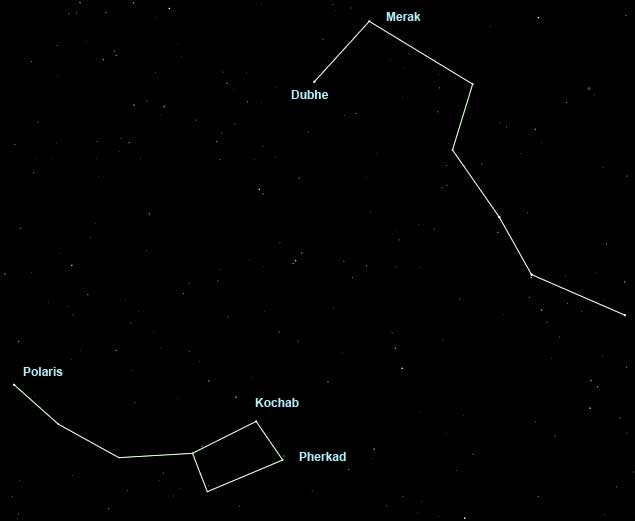How to See Ursa Minor, the Night Sky's Little Dipper

Recently I wrote about the constellation Ursa Major, the Great Bear, so this week I'll take a look at Ursa Minor, the Little Bear.
The seven main stars that form Ursa Minor are also known as the Little Dipper, whereas the seven brightest stars of Ursa Major constitute the famous pattern known as the Big Dipper.
Interestingly, the Big and Little Dippers are arranged so that when one is upright, the other is upside down. In addition, their handles appear to extend in opposite directions. The Big Dipper is by far the brighter of the two, appearing as a long-handled pan, while the Little Dipper resembles a dim soup ladle. (However, the late Ken Franklin, former chief astronomer of New York's Hayden Planetarium, used to tell his audiences that the Little Dipper looked more like a meat cleaver to him.) [Best Constellations in June's Sky Explained (Video)]
Astronomy neophytes sometimes mistake the Pleiades star cluster for the Little Dipper because the brightest Pleiades stars resemble a tiny skewed dipper. But in reality, most people have never seen the Little Dipper, because most of its stars are too dim to be seen through light-polluted skies.
The magnitude scale
If you ever wanted to judge the quality of your night sky, you need only look to the bowl of the Little Dipper. The four stars that comprise the bowl run in brightness from second to fifth magnitude.
The magnitude system has its origins in the classification by brightness of about 1,000 stars carried out by the Greek astronomer Hipparchus in the second century B.C. The average of the 21 brightest stars in the sky is defined as first magnitude, while the faintest stars normally visible to the unaided eye on a clear, dark night are said to be of sixth magnitude.
The magnitude scale is logarithmic. So, a difference of one on the magnitude scale corresponds to 2.512 times the amount of brightness. That is, second-magnitude stars are 2.512 times brighter than third-magnitude stars, and 6.31 (2.512 x 2.512) times brighter than fourth-magnitude stars, and so on.
Breaking space news, the latest updates on rocket launches, skywatching events and more!
The brightest star in the Little Dipper's bowl is Kochab, a second-magnitude star with an orange hue. The next brightest goes by an old Arabic-derived name, Pherkad, the "Dim One of the Two Calves." Pherkad is indeed dimmer than Kochab, shining at third magnitude.
The two other stars that complete the bowl are of fourth and fifth magnitude. So, if you can readily see all four stars in the bowl, you've got yourself a pretty dark sky. Unfortunately, thanks to the spread of light pollution in recent years, only Kochab and Pherkad are usually visible from most city and suburban sites, meaning the quality of the sky ranks from fair to poor in those locations. [Light Pollution Is Stealing the Night Sky's Darkness (Video)]
The North Star
The most important star in the northern sky is also in the Little Dipper: Polaris, the North Star. The best way to find your way to Polaris is to use the so-called "pointer" stars in the bowl of the Big Dipper, Dubhe and Merak.
Draw a line from Merak to Dubhe, extend it by a factor of five, and you arrive in the vicinity of Polaris, which is located at the end of the Little Dipper's handle.
Exactly where you see Polaris in your northern sky depends on your latitude; this star climbs progressivley higher the farther north you go on Earth. For example, viewers on the equator see the North Star right on the horizon, but from Minneapolis, Polaris appears halfway from the horizon to the overhead point (called the zenith). At the North Pole, you would find the star directly overhead. (Observers in the Southern Hemisphere can't see the North Star.)
Because of Polaris' proximity to the celestial pole, the star remains in very nearly the same spot in the sky year-round, while other stars circle around it. Only the apparent width of about 1.5 full moons separates Polaris from the pivot point directly in the north around which the stars go daily.
However, the Earth's axis wobbles on a 26,000-year cycle, in a phenomenon known as precession. The celestial pole therefore shifts as the centuries go by, meaning different stars have been the North Star at different times.
For example, Kochab was the North Star at the time of Plato, around 400 B.C. Polaris is actually still drawing closer to the pole, and on March 24, 2100, it will be as close to the pole as it ever will come — just 27.15 arc-minutes, or slightly less than the moon's apparent diameter in the sky.
Finally, many people believe that the North Star is the brightest star in the sky. This is not true; Polaris actually ranks only 48th in brightness. (The brightest is Sirius, the Dog Star.)
Joe Rao serves as an instructor and guest lecturer at New York's Hayden Planetarium. He writes about astronomy for Natural History magazine, the Farmer's Almanac and other publications, and he is also an on-camera meteorologist for News 12 Westchester, N.Y.Follow us @Spacedotcom, Facebook or Google+. Originally published on Space.com.

Joe Rao is Space.com's skywatching columnist, as well as a veteran meteorologist and eclipse chaser who also serves as an instructor and guest lecturer at New York's Hayden Planetarium. He writes about astronomy for Natural History magazine, Sky & Telescope and other publications. Joe is an 8-time Emmy-nominated meteorologist who served the Putnam Valley region of New York for over 21 years. You can find him on Twitter and YouTube tracking lunar and solar eclipses, meteor showers and more. To find out Joe's latest project, visit him on Twitter.
